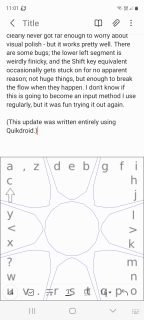There's a poll going around Tumblr asking the question, "Do you prefer writing on paper or a device, and if so, which device?"
The best device I ever had for writing was a PDA equipped with an input system called Quikwriting.
If you're not old enough to remember the days before smartphones, back then mobile phones only did the basic phone stuff like calling and text messages, and if you wanted to do other things, playing games and reading ebooks and writing and getting travel directions and so on, you had to carry around a second device to do those on. This device was called a personal digital assistant, or PDA.
And nobody had yet invented a tiny little keyboard that worked well for a majority of people, so there were a variety of other input systems available. Most PDAs came with a stylus that you could use to draw on the screen, so some input systems used that. Some claimed to let you write on the screen in your normal handwriting and it would be converted to text (and they even got it right
most of the time); some got you to write in their own adapted alphabet where each letter form was simplified and made more distinct from other similar letters. And some abandoned the alphabet entirely.
My favourite of the input methods I tried was Quikwriting, in which you wrote by making little loops with the stylus in the corner of the screen. Each loop began and ended within a central zone, and the size and direction of the loop indicated the character. If the stylus had left a trail while you were writing, it might have looked something like this:

...except that the words would all be written on top of each other without lifting the stylus. (And of course you'd write the loop that meant a space between each word, and the loop that meant a full stop at the end.) It took a while to memorise what the motion for each character was, but once you had it down you could write whole words, sentences, paragraphs in one long swoop.
It's the only input system I've ever used where I could write long passages as fast as I thought them, without having to keep an eye on the text to make sure that what I'd written was what I meant to write. And maybe, who knows, the fact that the physical motion resembled just doodling in a margin was also part of the appeal.
These days I have an Android smartphone with a tiny little keyboard that's okay for writing short messages and only occasionally tries to change what I've written into what it thinks I meant, but I don't use it to write anything of any significant length. As far as I know, nobody's ever made a proper implementation of Quikwriting for Android, and I suspect it wouldn't be the same using a finger instead of a stylus.
But maybe I'll go and look again, just in case...


